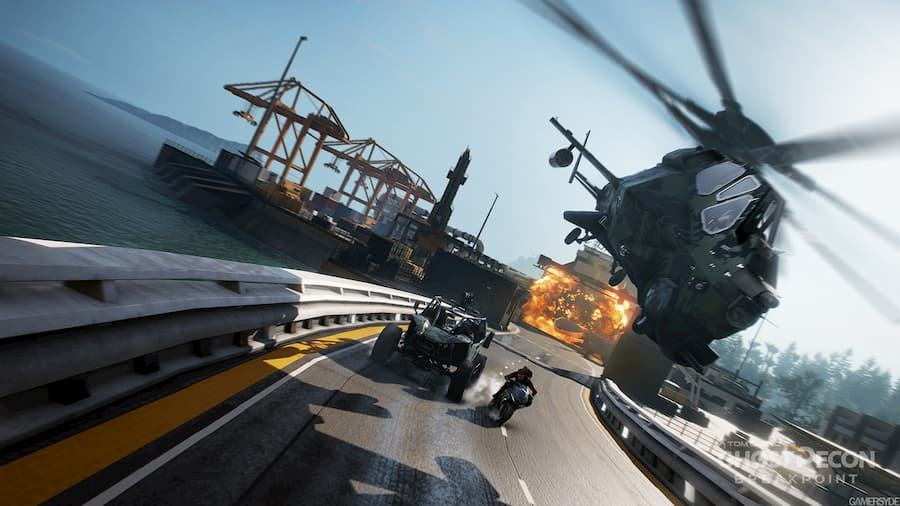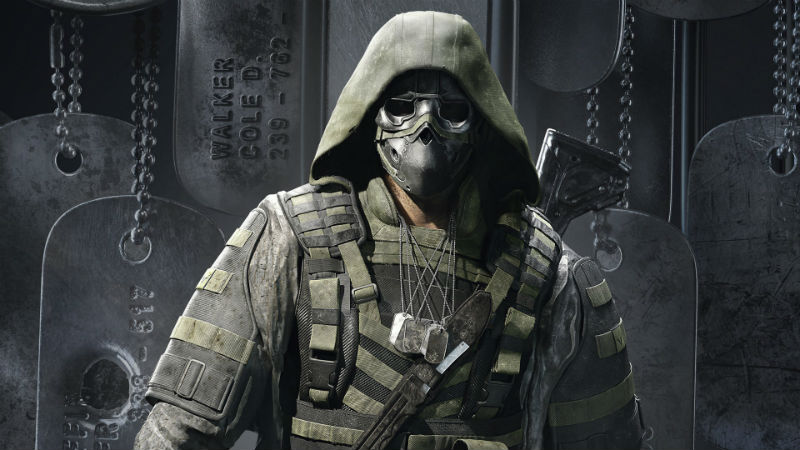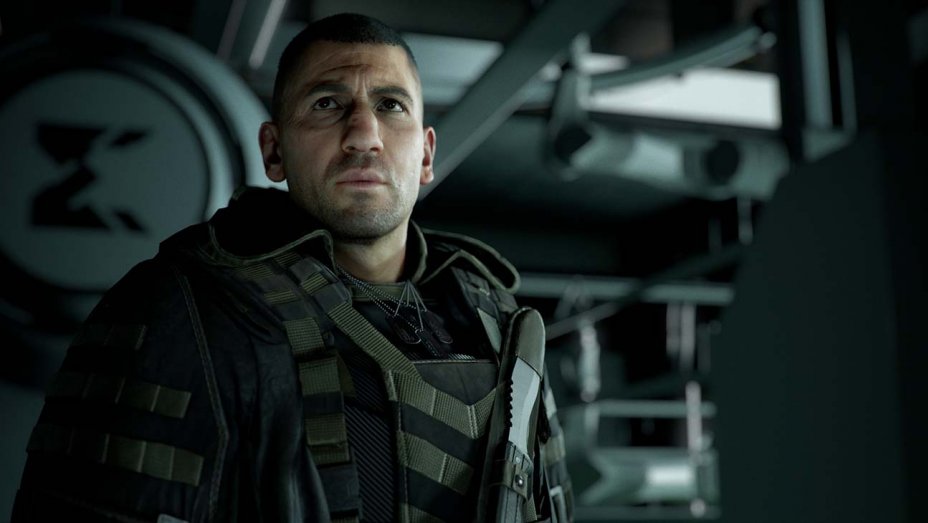
@offthegeekend
It’s no secret that Ubisoft loves their Tom Clancy series of titles. Rainbow Six Siege and The Division 2 have been seeing nice content updates to keep them moving, with the latter having just released earlier this year. And with the fall season comes a slew of new game titles, one of which being a new addition to the Tom Clancy Ghost Recon series: Breakpoint. Following six years after the events of Wildlands, Breakpoint takes the Ghost Recon fireteam to the island of Auroa to investigate Skell Tech and their weaponized drones. Upon arrival your helicopter is shot down by the island’s defense system, and this is where your journey begins…
Let’s talk about the campaign. Overall its your bog standard military storyline, changed up a little, with a dash of Ghost Recon thrown in. Don’t get me wrong– it was interesting enough to play through and keep me entertained, but it isnt an incredible story or have any amazing moments; Breakpoint‘s SPC is a worthwhile playthrough if you enjoy the franchise and like keeping up on its storylines. The dialogue is decent, save for a few odd or cringy lines. Cutscenes fill the gaps and provide enough backstory to not require playing Wildlands or the last DLC mission, Operation Oracle, designed to lead into Breakpoint and introduced Walker, Jon Bernthal‘s character. Although if you have Wildlands already, it’s worth playing that DLC mission to get that extra story lead-in, and, besides, it’s free.
The graphics and audio are on par with Wildlands, with maybe a touch better texturing and effects. This makes sense given they run on the same game engine, named AvilNext — the same engine used for Assassin’s Creed Odyssey and Rainbow Six: Siege. It is rather appealing visually, with the weather and day/night cycle adding to things. One moment it’s a bright day and then next you are trudging across the land in the middle of the rain. And after traveling across the island there is a greater appreciation to little details and efforts put into the world.

There are sections that are pretty basic forestry, but at the same time you’ll run into small encampments or houses of friendly NPCs that look more like they have purpose rather than just copy pasted into place. The roads are diverse, with buildings that aren’t all just cookie-cutter layouts placed around the map with different color schemes, and the land itself has some interesting places and variations to make it seem a bit more organic. That said, it’s still not perfect and could use more to help it feel more believable. There are times when a part of a building feels empty and lacking detail, left with a feeling of having no purpose in the daily life of the people working there. Many games tend to end up with these, unfortunately. The sounds in the game add depth as well, with audio cues helping the immersion and being useful to pinpoint enemy locations or warn you of incoming patrols.
Much like Wildlands there is an objectives board, but this time it is split into 4 areas: Objectives, Faction Missions, Main Story, and Special Operations.
-
- Objectives covers things you can find throughout the world to aid you in your travels and missions such as weapons, attachments, and collectibles and investigations that add to the story. The weapons and attachments are blueprints that can be created with scraps and parts, which you can obtain along the way or by dismantling weapons and gear. This works the same way as was done in The Division 2.
- Faction Missions are tasks or side missions that work as daily challenges. Completing these will add to a tier level, and at each tier you unlock rewards. These reset daily, but can also be replayed if you so choose. Rewards that can be unlocked include face paints, blue prints, weapon paint schemes, and item skins. While this sounds like story-disconnected challenges such as killing so many enemies or not being detected, Faction Missions actually include completing objectives and tasks for NPCs from the campaign. It’s definitely better than the former that most games use, and adds to the atmosphere of the game, making it a bit more interesting; offering something extra to do as a break from the main story.
- The Main Story section is exactly as it sounds: missions leading you through the primary part of the game, ultimately leading to the end of the story. It actually starts as an initial handful of missions, but then breaks off into two parts. Both tell a part of the overall story and are linked in the grand scheme of things, and lead you to various people in the story that introduce new information and background for the world. Future DLC will of course add into these objective sections, increasing the number of unlocks, people and places to discover, and story to uncover.
- The last part of the Objectives Board is the Special Operations. These relate to the multiplayer PVP part of the game, and have unlocks as well. These don’t add to the main part of the game, but do add to the PVP experience.

Moving onward! So now that you’ve got a basic grasp of the objectives, we can dive into the mechanics and general gameplay. Simply put, if you played Wildlands then you know how the controls work and how the gameplay feels. It has the same game engine, and not much, if anything, was changed for Breakpoint. This isn’t a bad thing though, as the game generally has a good feel, save for the driving which is OK on smooth terrain, but falls apart when introduced to even the smallest bumps or rough patches. This leads to either a quick, but at times frustrating travel between missions, or long runs across the map that are relatively easy yet tedious. Hot tip: get good at flying the helicopter, as it makes the trips shorter without having to battle with the terrain along the way. Just be aware of drones and other helicopters, as if they spot you, things will get challenging.
In terms of travel by foot, some people tended to dislike the difficulty added to moving down slopes, which if you moved too fast would lead to you losing footing and tumbling until you could regain ground. I was OK with this since this is relatively realistic and also isn’t hard to avoid. Crouching and moving slow will help keep you stable and avoid falls, while also allows you to remain aware of surroundings and sneak up on enemies. Little things like this add to the game feel rather than take away from it. The enemy AI presents a nice challenge, especially when playing solo. Whereas Wildlands has team AI that works with you during solo plays, Breakpoint has dropped this feature. Fear not as the devs have heard the initial complaints and are working to bring this back sometime during the Year 1 roadmap. For now you will have to rely on your drone and an ability named Sync Shot that has the drone aim and shoot at enemies you target when you fire on them.
Speaking of the enemies, not only does Breakpoint have the decent AI from Wildlands where they can spot you, alert others, and even hunt you down, but now also a drone system to provide air support and location notification to the enemy. Some drones just provide them with a eye on the area around them, some will actively hunt and shoot at you, and other larger drones in the sky will fly over and alert Walker’s team, The Wolves, to your location making things extra difficult. Should you get notification of these drones spotting you, stop drop and roll in the mud to keep them off your trail. Yes, I said cover yourself in mud. Part of your new evasion tactics includes the ability to go prone and cover yourself in the surrounding terrain to help blend in and avoid detection. This is one of the newer mechanics that I enjoy and hope stays in future titles. The first time I used this was in a muddy part of the map, and instantly reminded me of Predator when Arnold covered himself in the cold mud to prevent the bastard from being able to see his heat signature. Very cool.
So you can equip different guns, traverse the world in various vehicles, and even evade the enemy or sneak up on them when needed, but is there anything else to this shooter? Of course there is. Much like Wildlands you can open up a gunsmith section to add attachments and weapon schemes/paint sprays. You can also upgrade the weapons to increase their function such as damage output and range, although only in small amounts and require points that you earn to be spent on them. There is also a skill section like Wildlands, but this time it’s sort of a hybrid between The Division 2‘s abilities and Wildlands‘ skills. In Breakpoint there are four classes you can unlock, each with their own ability and skill, ultimately giving the player the usual choices of being a healer, sniper, assault, and stealth/rogue. You can unlock all 4, but can only use one at a time; switching between them when you stop at campsites called bivouacs.

Beyond these four classes you can unlock various skills that increase your passive abilities in stealth, tactics, sniping, weapons, drone use, survival, gadgets, and assault. Some of these have to be equipped into a perk slot to be enabled, while others are passively active when unlocked. Initially you start with only one perk slot, but can unlock up to three of them. These can be switched up while out in the field and do not require stopping at a campsite to change. This is great for when you want to apply stealth for entering a military installation, but then switch to drone evasion tactics when traveling to the next mission point. Or maybe you are on the attack and want extra XP, then you can enable a perk that gives bonus XP for any kills on enemies that are spotted with your done. Yes.. the drone function is still here, and acts much like it did in Wildlands, allowing you to spot enemies, move around to view the layout of an area, and scout to see if there are any enemies on the path ahead. Super useful, although I am always shocked how close you can get to NPCs without alerting them. It’s not completely silent and is quite large and visible for them to not spot it, but they seem to be oblivious to it’s flight most of the time.
I can’t end the review without at least touching on the multiplayer aspect. While I did not get a chance to play a lot of the PVP, this was changed up and had more effort put into it than with Wildlands. If you followed the previous game from release up until earlier this year, you’ll know that the PVP was actually added in later. So initially all you had was solo and co-op campaign play. Going into PVP mode was similar to most games where you partied up in the menu and initiated a search for PVP games. In Breakpoint this was baked into the game from the start. In fact the game itself requires a connection to the internet due to how it is integrated, much like The Division 2.
So how do you go about joining a party and PVP game? Simply join up with friends in the menu or you can do this in game at the main characters main base of operations, a massive cave at the center of the island named Erewhon. It is here where you can shop for new weapons, attachments, equipment, and cosmetics, as well as find other players to join up with or search for a Ghost War PVP game. The PVP game portion is pretty simple with 2 modes: Elimination and Sabotage. Both are 4v4 with Elimination playing like team deathmatch, but with a shrinking map, similar to battle royal games. Sabotage sees one team attempting to plant a bomb while the other team has to stop them or diffuse it. I enjoyed the short amount of time spent on trying both and plan to continue.
My personal gameplay was mostly in the campaign, trying to follow the main story, and once in a while running off to complete a side mission or talking to a friendly NPC to open up a new one. As I said before the campaign isn’t anything amazing, but still fun, so I often found myself enjoying going through the missions trying different tactics, clearing NPC outposts, and essentially roleplaying through the world. There’s something gratifying about sneaking outside a base of operations, picking off the guards, then sneaking in and seeing how far you can get before being spotted. That’s when the fun begins and you go into defense mode; taking cover behind desks and walls in good Tom Clancy game fashion, peaking up and taking shots at the approaching enemies to clear them out, and continue on your way to complete the mission and uncover more of the story.

In the end, if you enjoyed Wildlands, there’s no doubt that Breakpoint is worth a play. Casual players may want to wait for a deal closer to $40, while hardcore Ghost Recon players may find $60 worth the price of admission. If this is your first foray into the series I would say wait for a deal between $30-40. Black Friday sales are just around the corner, and given the lack of team AI that is eventually being added to the game, waiting for a deal is a solid way to go with this title — even better if the Gold and Ultimate editions dropped in price, adding the Year 1 Pass to the deal. 3.5/5 Drones.
-Patrick Obloy

